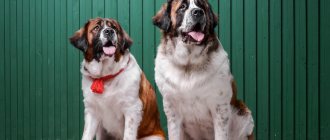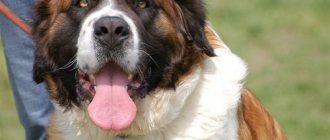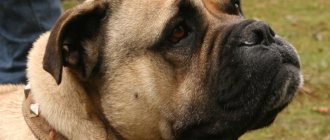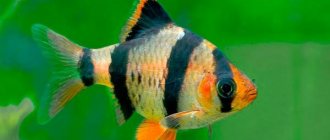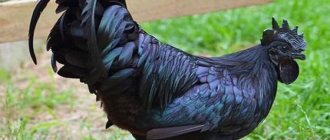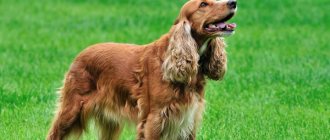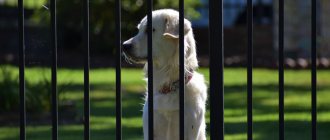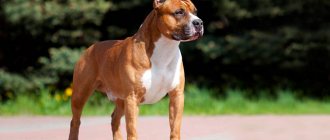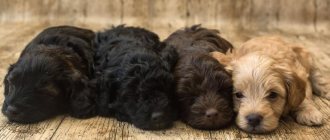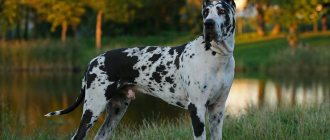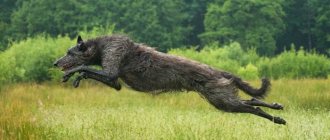Description of the history of the breed
This breed is one of those few, the creation and modification of which were carried out by the best biologists and breeders. This unusually strong and fast breed was bred specifically by order of government authorities. And while the history of other breeds is shrouded in mystery, the pedigree of Muscovites is open and transparent, and the fact that they were born for a special mission only adds prestige and charm to the breed.
After a war that not only claimed thousands of lives, but also left many dogs homeless and shelters destroyed. The workers of the Krasnaya Zvezda kennel, which was located in the Moscow region, were tasked with raising dog breeding from its knees. The letter that came “from above” clearly stated: “ To breed a breed for protection that would correspond to a high class of speed, endurance, physical strength and is easy to train .”
The basic breeding “ingredients” of the work were the St. Bernard and the Caucasian Shepherd - these two breeds, absolutely polar in character, gave birth to such an unusual combination. Also involved in the process:
- German Shepherd;
- Newfoundland;
- Russian greyhound;
- Russian piebald;
- Russian hound.
This was a very difficult job, because it is always more difficult to correct the results of multi-species crossing, but Russian cynologists coped with the task perfectly.
Not only the best and healthiest representatives of the breed were chosen for crossing, but also those who distinguished themselves during military operations and hostilities. The entire procedure was carried out in the fifties of the twentieth century. The entire process was supervised by A.P. Mazower, owner of the shelter. The firstborns of the breed were shown at an exhibition in Moscow, but at that time they were still listed in the documents as a “crossbreed”.
Subsequently, the breed was modified, and all changes were documented. The parents of purebred Moscow watchdogs were Ashi (Caucasian Shepherd) and Barry (St. Bernard). The government's order was carried out. The standards and basic traits of the breed were documented in 1958, although they have changed several times since then.
All subsequent work on breeding dogs and maintaining the breed population was carried out by amateurs on a voluntary basis. Most amateur dog breeders note that the breed has changed for the worse. Absolutely all breeds go through this process on their way to the ideal.
Walk
Representatives of the breed need long-term walking and physical exercise. The ideal place for a dog to live is a country house, where it will have free access to the territory.
If a representative of the breed lives in an apartment, then you need to walk him at least 2 times a day. The duration of the walk should be at least 1-2 hours.
If you need a dog that is ideal for keeping in an apartment, we recommend reading the article
It is not enough to just walk down the street with your dog on a harness . Walks should be active.
They should include jogging, elements of training and games such as agility . However, you should not overload the dog either.
The skeleton of a representative of the breed is in the process of growth and strengthening for up to a year. During this period, loads should be moderate
Characteristic
The Moscow Watchdog is a large specimen with a wide skeleton and massive muscles. The body is slightly elongated, the paws are long and large.
The dimensions are as follows: height at the withers for males - 68 cm, for females - 66 cm. The weight of males is from 60 kg and above, while females weigh from 45 kg.
- The neck is wide and short, with a slight overhang possible.
- The head is also large, the forehead is wide. The transition to the muzzle is clearly defined.
- The ears are drooping and triangular in shape. The eyes are round, dark, deep-set.
- The bite is oval, the teeth are large and sharp.
- The chest is wide, the back is straight, the height at the withers should ideally be slightly higher than the height at the rump.
- The front and hind legs are straight and isometrically fixed. The length of the forelimbs is equal to half the height at the withers. The paws are large and round.
- The tail is wide, located high, its length reaches the hock joint. The base is located in line with the croup; when active, it rises in the shape of a sickle above the line of the back.
- The coat is thick and shiny with a dense undercoat. On the head it is a little shorter, and males have manes, fox tails, and trousers, giving the dog even more aristocracy and volume.
- The color is light red or light red-brown. There are black markings on the face and ears. It is considered a good sign when the entire chest, collar, front legs along the entire length and hind legs up to the knee joint, the tip of the tail are white. Particular attention is paid to the color of the muzzle: black “glasses” should have a symmetrical shape and completely cover the eyes, and there should be a white mark in the center of the muzzle.
The Moscow Watchdog is more active than its ancestor, the St. Bernard, and moves at a shallow trot or a heavy gallop.
Photo
Adult
Photo with a person for clarity of size!
Puppy
Appearance of the Moscow guard dog
A formidable giant with the muzzle of a St. Bernard and the shaggy hair of a “Caucasian” - this is approximately the impression the Moscow watchdog makes when first meeting him. By the way, despite the deceptive similarity between the Moscow watchdog and the “alpine rescuers”, there are quite significant differences between them. In particular, the Red Star players, although considered giants among their peers, are somewhat inferior in size to the Swiss. The minimum permissible weight for an adult male Moscow Watchdog is 55 kg, for a St. Bernard - 70 kg. The MC's skull is significantly narrower than that of its Alpine relative, and the transition from the forehead to the muzzle is relatively smooth. In addition, “Muscovites” are distinguished by a stronger constitution and an elongated body, complemented by an amazing ease and dexterity of movement for such giants.
Head
Moscow watchdog with a man
Large, high cheekbones, with a moderately convex, wide forehead, crossed by a longitudinal groove. The muzzle of the Moscow watchdog is blunt and voluminous, noticeably shorter in length than the skull. The infraorbital region is normally filled, the brow ridges and the occipital protuberance are clearly defined.
Lips
“Muscovites” have fleshy lips of a rich black color, without jowls.
Jaws and teeth
The jaws of the Moscow watchdog are massive, with a scissor bite. White teeth in the amount of 42 pcs. fit tightly to each other. The incisors are located along the same line. The absence of several teeth, provided that they were broken or knocked out, is not considered a defect.
Nose
The purebred Moscow guard has a black lobe, very large and noticeably elongated in width.
Eyes
The deep-set, small eyes are tightly covered with black eyelids. The standard shade of the Moscow watchdog's iris is black.
Ears
The correct shape of the ear is triangular, with a softly rounded tip, set above the dog’s eye level. The cartilages support the ear flap in a hanging position, so that the anterior edge of the ear touches the zygomatic area.
Neck
The neck of the Moscow Watch is muscular, of medium length, with a well-developed scruff and moderate dewlap. The latter may be absent in some individuals, which is not considered a disadvantage.
Muzzle of a Moscow guard dog
Frame
Unlike St. Bernards, Moscow watchdogs can boast a more elongated body type. The withers of the “Muscovites” are high and are especially striking in males. The back is strong, of good width, with a short loin and a voluminous, slightly sloping croup. The MC's chest is deep, with convex hoops of ribs that widen towards the croup. The lower line of the abdomen is slightly tucked.
Limbs
“Muscovites” have straight, parallel legs. The shoulder blades are of sufficient length, set obliquely, the shoulders are well muscled. The thighs of representatives of this breed are the same length as the shins. The dog's paws are massive; the front ones are round in shape, with thick elastic pads, the rear ones are more reminiscent of an oval. The animals' dewclaws are removed.
Tail
The tail of the Moscow watchdog continues the line of the croup and is quite thick. In a relaxed animal, the tail drops down, forming a slight bend at the tip; in an excited animal, it takes the shape of a crescent and rises above the back.
Wool
Moscow watchmen
The coat of the Moscow watchdog is abundant, double, consisting of guard hair and thick undercoat. The most stylish appearance is distinguished by males, whose decorative coat forms a spectacular collar on the neck and flirtatious feathering on the back of the legs. The Moscow guard bitch's "outfit" is much more modest due to the smaller amount of hair.
Color
White with red, red-black, black-red or sable spots. Colors that do not have a red tint in any of the listed variations are considered non-standard. In addition, the dog’s chest, tip of the tail and paws (front to the elbow joint, rear to the shins) must remain white. The head of the Moscow guard is framed by a black “mask”, complemented by the same “glasses”. The ears of representatives of this breed are also black.
Disadvantages and possible defects of the breed
Disadvantages that an animal will not receive at an exhibition are:
- excessively long neck with too much dewlap;
- ears in a semi-erect position;
- short tail, curled into a ring or hook;
- shoulder blades too short;
- a narrow head with an overly smoothed or, conversely, sharp stop;
- pendulous, pocket-shaped lips;
- very light color of the iris, obliquely set eyes;
- insufficiently wide feet;
- proximity of the hock joints;
- curly and curly hair (light wave is acceptable);
- square body;
- asymmetrical muzzle color;
- insufficient growth.
Moscow guards with the following physical and mental disabilities are subject to complete disqualification:
- nervousness, cowardice;
- congenital lack of teeth (broken and knocked out teeth do not count);
- amble;
- brown color of eyelids and earlobes;
- distorted jaw;
- malocclusion;
- disagreement.
Dogs with dewclaws, cryptorchidism and unbalanced, loose movements are also rejected.
Character
Sad and a little melancholy, Moscow watchdogs are loyal friends to their owners and his family members. These dogs are distinguished by increased endurance, lack of fear and determination in protecting the owner. The presence of such a dog will allow owners of private houses and those who live in the private sector to sleep peacefully.
Moscow watchdogs never “give back” in the face of difficulties; they are always aimed at protecting the territory. In addition, this dog gets along well with children and pets, which captivates many owners. These dogs are very smart and loyal, they are always on guard of their immediate environment.
It is worth noting that the Moscow watchdog is not a “barking” dog; barking is only given in cases of emergency , when there is an external threat. These dogs are easy to train and always obey, which makes them high-class “guardians.” The Moscow Watchdog loves an active lifestyle, but easily adapts to a calm rhythm, to the conditions of protecting the territory in a “quiet” mode.
With proper training and a competent approach, dogs of this breed become true friends of a person, leaving a significant mark on a person’s soul and memory. But you shouldn’t immediately leave them alone with small children without supervision; Moscow watchdogs can accidentally harm a child, simply because of their large size.
It is advisable to trust such a dog with the defense of land and private property, since keeping Moscow watchdogs in apartments is undesirable.
The character of dogs of this breed requires communication with a balanced, calm, kind person. The character of this breed can be briefly described as follows: “Less words - more action.”
FAQ
Let's consider frequently asked questions regarding the breed:
Question to the expert
1. Is it possible to give an older puppy sticks to chew on?
Sticks are a source of increased danger and injury. It’s better to buy beef sugar mosol with meat and give it to your pet.
2. What should you pay attention to when choosing a puppy?
First of all, on his mother and the environment. If there is dirt everywhere and the bitch looks bad, run away from such a kennel. If the mother is thin, but she has healthy, clear eyes, calm behavior, the environment is clean, and the puppies look well-fed, feel free to take the baby. The second point is the appearance of the puppy. Clean, shiny eyes, healthy look. Pink ears and tummy, no red dots on these areas of the body. The puppy should be active, curious, a little cheeky and playful.
3. What to do with an affectionate dog?
Feed, love and never offend. Seriously, any dog can be “broken” to suit you. But the cost of such a breakdown is high, do you need it?
4. Why does the FCI not accept this breed?
Only representatives of the International Canine Federation can answer this question.
5. Is it true that the Moscow watchdog hates cats?
It all depends on the character of the particular dog and its upbringing. In general, representatives of the breed get along with other pets.
Price: how much does a puppy cost?
There are many nurseries that offer interesting deals. Buying puppies from a nursery, of course, will cost much more, but you get a guarantee that you are purchasing a “Muscovite” and not a mixture of breeds. This puppy will carry the genes appropriate for the breed. Also, all puppies from the nursery are healthy and without developmental disorders.
On the market and through advertisements, it makes sense to buy puppies only to save money, but at the same time you need to be prepared to stumble upon a crossbreed. In such cases, it is advisable to look at the parents, but still, in the absence of documents, it will be difficult to make a claim to the seller.
The average price for a second hand purchase is 15,000 rubles. In nurseries - 20,000 rubles.
REFERENCE! Sometimes large nurseries hold promotions, selling purebred dogs at a lower price.
Is he afraid of shots?
The dog is not afraid of shots, which means it can be an assistant during the hunt, when guarding military enterprises, and noisy industries.
How long do they live?
Moscow watchdogs live relatively short, like most large dogs, from 8 to 10 years.
Mating
Puberty reaches dogs at 8-10 months , but since Moscow watchdogs take quite a long time to mature, the best age for mating a female is 18-20 months , and for a male - 2 years . The third heat is a signal that indicates the girl has fully matured. On days 13-15, symptoms of readiness should appear: a swollen loop, light pink discharge, playful behavior. Most often, dogs lick the genitals, so it is advised to apply cotton wool to the loop to find out about the appearance of bloody lubricant.
Breeding bitches must be registered in nurseries and certificates for mating must be obtained for them. You need to initially select a suitable male and agree on mating in advance. Animals must be checked for the presence of pathologies and diseases, and deworming should also be carried out.
Animals need a lot of free space. The bitch is brought to the dog, where the dogs are given time to sniff and get to know each other ( 10-15 minutes). If everything goes well, the girl will allow you to do the cage. The act will last 5-10 minutes , the lock - 15-20 . At this time, the female should be supported under the belly, not allowing her to sit down. The boys are sent to the noose. An experienced specialist is usually invited to decouple the dog. Mating is repeated after 2 days.
Maintenance and care
Muscovites can live in either a small apartment or a spacious garden plot, but they like freedom and open spaces. It is worth noting that they quickly find a common language with people, obey them, but are always ready to fight enemies who encroach on the life and health of the owner.
A dog changes its “fur coat” twice a year, so it is so important to monitor the condition of its coat and comb it to avoid disease and hair loss. The most important thing is to introduce your pet to brushing from a young age, then there will be no problems with a lot of hair in the bed and on clothes, and the pet will always be combed and well-groomed.
It is important to remember that neglecting wool treatment threatens the formation of tangles, which will cause discomfort to the animal and pose a big problem for the dog’s owners.
Combed beauty!
Bathing should be done at least four times a year , but you can wash it more often if the coat is dirty. Moscow watchdogs love to swim in open waters, so the owner should not interfere with his pet’s play activities. Swimming in ponds, rivers and lakes well strengthens and distracts these huge dogs, which plays “in favor” of the owner.
The dog owner needs to monitor vaccinations (against gastroenteritis, distemper, rabies, leptospirosis). Be responsible about your health so as not to spend a lot of money on treatment. You also need to remember about prevention against worms and ticks.
The starter kit for the “Muscovite” includes:
- Set of bowls;
- Brush;
- Leash;
- Collar.
You also need to allocate enough personal territory for the animal in the apartment, where it will be comfortable and calm. But it is more correct to keep dogs of this breed in an open area, providing them with an enclosure and a booth with insulation. Muscovites tolerate heat and cold well, which elevates them to the class of “universal soldiers.”
Walking with a dog of this breed consists of 2-3 trips into the fresh air, lasting at least 60 minutes.
Attitude towards children and others
The Moscow Guard Dog is non-aggressive; She treats children well and even tolerates many of their pranks. But it’s still not worth leaving it alone with the child - being distinguished by its impressive size, it can unintentionally harm the child. However, under the supervision of adults, this dog is a real find for parents: they enjoy playing with children, and in the winter they even enjoy taking them on sleds.
The dog behaves warily towards strangers, watching their every move when they are outside the threshold of their home. Aggressive behavior on their part is observed extremely rarely: despite the fact that these dogs are recognized as excellent defenders and guards, they can only raise their voice in a situation of extreme necessity.
What to feed?
You need to feed your dog meat, mostly raw. Do not give long bones, because this dog more often than others swallows them whole, as a result of which it has problems with digestion. You will also need porridge with water, vegetables and, possibly, fish (if there are no allergies).
Accustom your dog to a certain diet and menu. Always feed at the same time, this will help develop the dog’s character and will also be convenient for you. The owner must provide food exclusively .
You can also use dry food, but keep in mind that it is expensive to provide the Moscow giant with the necessary amount of ready-made food per day.
Feeding the puppy
The puppy must be fed cottage cheese with kefir, beef, rice and buckwheat porridge with (preferably) goat milk . It is ideal if you take care of vitamin supplements for your puppy.
Remember : babies of any size are prone to stomach upsets, so introduce each new product into complementary foods gradually, with a break of 2-3 days.
Cerberus diet depending on age: what should you feed your puppy? The best porridge for a puppy: feed it tasty and healthy
The main health problems in this breed arise in the joint-ligamentous system and the hormonal system.
Allergic reactions and possible obesity in these dogs can be eliminated by the owner, but all measures should be carried out only under the supervision of a veterinarian. Like all mammals, dogs are susceptible to viral diseases, including pandemic ones, which once again proves the importance of vaccination and medical diagnosis
Nutrition
When choosing the type of food - dry food or natural food - it is better to give preference to natural food, since ready-made food for such a dog will not be profitable. At the same time, the animal’s diet should be varied. Main menu: porridge cooked in meat broth. The animal should also be served raw vegetables and fruits, fermented milk products and boiled fish without bones.
A puppy's diet is very different from an adult's. For example, you need to feed your baby 5-6 times a day in small portions so that the baby always receives the necessary components for growth and development without overloading the gastrointestinal tract.
The main components of feeding a puppy:
- Milk porridge
- Small pieces of raw meat
- Plenty of fermented milk products: sour cream, kefir, cottage cheese. They should be served to the baby daily to prevent rickets and other diseases of the musculoskeletal system.
- Fruits and vegetables
- Some offal: beef stomach, liver, lungs and kidneys
By consuming these foods, the Moscow Watchdog puppy will receive the nutritional components necessary for growth and development. From the diet of an adult dog, the amount of consumption of fermented milk products is almost reduced to several times a week. In this case, the emphasis is on feeding large pieces of meat and offal. This is necessary to maintain oral and gastrointestinal health.
Cereals:
- Buckwheat
- Rice
- Pearl barley
- Hercules
Meat components:
- Beef
- Mutton
- Game
- Beef by-products
Vegetables and fruits:
- Potato
- Beet
- Apples
- cucumbers
- Carrot
It is strictly forbidden to include in the diet:
- Pork and pork by-products
- Smoked and marinated products
- Foods with lots of spices and salt
- Sweets
- Flour baked goods
Its life expectancy and health depend on proper maintenance of the dog.
Training and education
The first step is to teach the dog order and discipline, because such a breed can even accidentally harm humans and other pets. The dog should follow simple basic commands (“Stop!”, “Get down!”, etc.) from the age of 2-3 months. The main feature of this breed is their long stay in the childhood period, which complicates the training and upbringing of the puppy.
However, with the right approach, Moscow watchdogs can quickly learn the necessary skills, which usually involve protecting the life and territory of the owner. If you lack patience and training skills, it is recommended to contact specialists.
Since dogs of this breed are very intelligent and active, they are quite easy to train. The most important thing for the Moscow watchdog is to delineate its specific location, because it will always protect its territory . Also, do not forget that you yourself must be strong in character and disposition and not give up your positions, as the dog will try to take a dominant place in his new pack. Do not be afraid of the dog or show fear under any circumstances - the dog may perceive this as a sign of weakness and will stop obeying and respecting you.
The dog is very active, so it is important to give it the right amount of physical activity, however, all attempts to bite the owner, even playfully, should be stopped. Do not intentionally develop aggression in the breed, because it cannot always be controlled.
How to train a dog is an individual matter, and the most important thing in this is to lay the right foundation . Try to find a middle ground between a loving and affectionate owner and a tough trainer. The dog must understand that you are its owner. But still, if you have any difficulties, problems, or want to teach your dog something specific, you can always turn to the services of a dog handler.
But you should remember that each dog also has its own character, do not break it if you do not want to raise a simple machine to protect the yard or house. After all, it is much better when the dog is not only a guard, but also a wonderful friend for the whole family.
Appearance and characteristics of the breed
A typical representative of the breed is large, massive, tall and broad-bodied. Anyone who has seen a “Muscovite” will confirm: the dog has an intense gaze, a specific facial expression and a very beautiful exterior.
As for character traits, the Moscow Watchdog was once considered one of the most vicious and distrustful breeds. At least the dogs treated strangers in this way; they were obedient and even affectionate with their owners.
Today's “Muscovites” differ in character from their ancestors. Most dogs have forgotten what aggressive behavior towards strangers is.
Health and illness
- The main weaknesses of this breed are considered to be diseases of the joint-ligamentous system and the hormonal system.
- Improper feeding and maintenance can cause allergies. Allergic reactions and possible obesity in these dogs can be eliminated by the owner, but all measures should be carried out only under the supervision of a veterinarian.
- Like all mammals, dogs are susceptible to viral diseases, including pandemic ones, which once again proves the importance of vaccination and medical diagnosis
A dog for the elite
Research has revealed that only an authoritarian, intelligent extrovert with a balanced psyche can properly raise such a dog.
According to observations, bitches serve more diligently, but do not recognize the authority of family members, considering only the owner to be the leader. At the same time, males are prone to conflicts and fights.
Differences with St. Bernard
Are Moscow Watchdog and St. Bernard not the same thing?
Since these two breeds look very similar to each other, we hasten to dispel this myth - they are not the same breed. St. Bernard is the progenitor of the Moscow watchdog, therefore the external color and size are extremely similar.
What is the difference?
Saint Bernards are very massive by nature - the weight of these dogs can reach eighty kilograms, and their height can be up to seventy centimeters at the withers. Therefore, their closest relative is also considered a large breed. The height of the Moscow watchdog is also about 60-70 centimeters, but the dog itself is much narrower and drier in the body than its ancestor. Therefore, the usual weight for this breed is 45-50 kilograms.
Try to find the differences between the Moscow Watchdog and the St. Bernard in the photo comparison:
The St. Bernard's head is wider and larger, and only one specific type of color is allowed for this breed. However, if you look at it from the other side and pay attention to the tail, the Moscow watchdog’s tail is not capable of curling into a donut, more even than that of its ancestor.
The main external highlight of the St. Bernard has always been considered to be deep, seemingly sad eyes and large ears hanging right down to the end of the muzzle. His ancestor did not inherit such long ears - usually their length is limited to the zygomatic cavity, and there is no wide lower eyelid, creating the effect of “sad eyes”.
Saint Bernard
The most important and important difference between these two breeds is their character . Saint Bernard is a breed recognized all over the world, has an unusually calm and balanced disposition, is good-natured like a teddy bear and is able to come to a person’s aid, despite its impressive size.
The character of the Moscow watchdog differs significantly. A dog of this breed was bred specifically for protection, because it is more willful, can show rigidity in behavior and show aggression. In the absence of proper training, this breed can cause a lot of problems both for the owner and for the people around him. However, this does not mean that she is evil! No - this is an active but strong animal that needs to be taught to communicate!
Moscow watchdog
If you still compare the main traits of their characters, the St. Bernard is suitable for a family with children , he will not offend or bite members of his “pack,” and the Moscow watchdog should be taken to a house where a guard is really needed .
The similarity of these breeds is that they are very unpretentious and not capricious in their maintenance - both in feed and walking rules. The main problem of these two dogs can only be the presence of thick hair, which is not very easy to comb out and bring into proper shape every time they shed.
Advantages and disadvantages
As a result of long breeding work, the breed now has many advantages, such as:
- developed guard and service abilities;
- equilibrium;
- loyalty to the owners;
- quick memorization of rules of behavior and commands;
- ease of maintenance and care.
However, the future owner should take into account the difficulties associated with the large size of the dog.
The Moscow watchdog must be provided with:
- strict upbringing, early socialization;
- regular combing of the coat, especially during the molting period;
- selection of a balanced diet, sufficient portions;
- room for movement or long walks;
- frequent active exercises.
Without control and training, the dog will be problematic and unsafe for others.
Owner reviews
Tatyana writes: Our family always had dogs, but for some reason they were mostly Collie breeds. But after we saw this fluffy miracle, which shook its ears and joyfully ran towards us, there was no doubt left, we are taking this dog! So a new friend appeared in our family, who perfectly guards the house and does not allow strangers into the yard, always greets his owners, is very smart and quick-witted. In a word, not a breed - but a fairy tale! He’s been living with us for 10 years now, and we’ve never regretted buying him!
Maryana says: When my husband and I decided to move from an apartment to a private house, there was no doubt - there should be a dog in the yard. We didn’t understand all the intricacies of breeds, characters, feedings at all - we just thought about making a friend for the soul and not bothering ourselves. One day, in one of the advertisements, I came across photographs of fluffy balls and immediately fell in love - I took my husband with me and we went to look and choose. As soon as we saw their parents - tall and menacing handsome men with massive paws - we knew we had come to the right place. Since then, Ralph has lived with us - a huge dog who lives up to his breed as a Moscow watchdog - he guards the house and makes us happy.
Andrey shares: This breed is what I needed! I have always dreamed of a characterful, large dog that would be a joy to my soul. And so, when I bought it and began to work with it, I realized that the Moscow watchdog perfectly suited my character and lifestyle. Excellent training ability, requires physical activity. The only problem is the fur, you need to keep an eye on it, otherwise it will start to mat. And the breed is simply super. I recommend to everyone.
Complaints and possible problems with the breed
Elena: I never thought that giving a dog a bath would be such an adventure. And you will have to bathe her five or six times a year, because this shedding will simply drive you crazy. The coat needs care, and without proper attention, the dog will begin to smell, and after that, these lumps will only have to be cut off.
Dmitry: Well, I had a hard time with training! I took a dog from a kennel, they promised a pure breed, excellent character. As a result, my Milo at first did not understand at all what I wanted from him. When teaching the command “Place!” and completely growled, made a sad face and turned away. As soon as he was put on a chain, he gnawed everything he could reach. I solved this problem only with the help of a dog handler, because I thought that I myself could only make the situation worse. Therefore, keep in mind that all dogs, like people, are individuals. Be prepared for difficulties.
Victoria: I didn't have any particular complaints about this breed. However, as soon as summer arrived, and here it is hot, I realized that the Moscow watchdog tolerates the summer heat disgustingly. Our Lady could lie for days without even raising her head in the shadows - let alone protection. Every time she had to carry a bowl of water directly under her muzzle - she was too lazy to even get up to drink. That’s why I don’t even know if it’s my mistake in choosing the breed or if it’s just the dog’s character. I'm not very happy with this display of laziness. This breed has always seemed active and cheerful to me.
Kinds
There is only one species - the Moscow Shepherd guard dog , but to consolidate the differences with relatives, a few words about the ancestors.
- Caucasian Shepherd Dog. One of the breeds bred in Russia. Or rather, it originates from antiquity, from the Molossians, but breeding work began at the beginning of the 20th century. The range of modern dogs is areas close to the Caucasus Range. Height at the withers is up to 75 cm, weight up to 70 kg, but can reach up to 110 kg. Considered one of the largest dogs in the world.
The coat is thick, with undercoat. There are three varieties: long-haired, medium-haired and short-haired. The fur color is closer to wolf, gray-brown-fawn. The ears must be cropped, since the dog’s main job is as a shepherd, protecting the herd from predators. And the ears get in the way in a fight.
The character is courageous, decisive, distrustful of strangers. Distinctive qualities are fearlessness and anger. But the owner is the most important being in his life. The dog is literally ready to give his skin for him.
Caucasian Shepherd, one of the largest dog breeds
- Saint Bernard In appearance, the Muscovite is most similar to this breed. But it weighs a little less. The difference in height is not very noticeable, the Swiss at the withers is up to 70 cm, but his weight is much greater - by 10-15 kg. The name comes from the monastery of St. Bernard in the Alps. There is information that this monk organized a shelter for lost wanderers in the mountains. And local dogs helped him find travelers frozen in the snow.
Subsequently, the monks of that monastery often used the “dogs of St. Bernard” to detect people in avalanches. And now the main purpose of the dog is as a search and rescuer. After an avalanche, the St. Bernards are provided with the necessary equipment, food, water, clothing, and sent to look for people in the thick snow. And they really saved the lives of hundreds of victims. This is largely due to the dog’s glorious character. He is obedient, devoted, loves all people, and is very careful in his handling.
The St. Bernard is very similar in appearance to the Moscow Watchdog, but the breeds also have differences
Some interesting facts
- There are cases in history when the owners of these dogs entrusted them with the care of small children. And it must be said that these animals coped with the task with all 5 points. Moscow watchmen are always on guard for threats, vigilantly monitoring the territory and people entrusted to them.
- Moscow watchmen are called upon to serve people, which they do just as well. Huge, somewhat clumsy-looking dogs always treat people with kindness. They feel the mood and will not pester the owner if he is busy or out of sorts.
- You have to try hard to raise such a dog to be sloppy or disobedient. Still, many years of history and genetic factors have laid down certain rules and disciplinary norms in the subcortex of each new individual.
- These dogs are often used for rescue operations, particularly by firefighters and coastal patrol.
Tips for choosing a puppy
Seven weeks of age is the best time for a puppy to move from its mother to a new home. It is better to make acquaintance earlier so that the pet gets used to human attention, especially to the image of its future owners. Before choosing a baby, observe the mother's behavior and reactions. By her behavior you can roughly understand what character her offspring will inherit.
Moscow Guard puppies should be medium in size - weighing about 3.5-4.5 kg. Feel free to carefully examine the animal, its belly, paws, eyes.
Best nicknames
How to name a Russian dog:
For boys
- Captain Shrek
- Mr. Rachok
- Prapor
- Buffalo
- Vladimir
- Abu
- San Sanych
- Kamikazde
- Partisan
- Illidan
- Garrosh
- Thrall
- Wooljin
- Mut
- Zolic
- Shedar
- Saiden
- Charm
More than 100 boy dog names: choose with taste
For girls
- Silvana
- Alleria
- Sonya
- Bagheera
- Mandrake
- Lesya
- Titmouse
- Martin
- Baby
- Thumbelina
- Hermione
- Paprika
- Liquidation
- Storm
